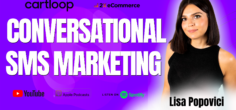Podcast
Learn from Fast Growing 7-8 Figure Online Retailers and eCommerce Experts
Removing Unintended Road Blocks in the Checkout Process
Retailers often focus on engaging shoppers at the top of the funnel, which typically involves onsite user experience optimisation, and driving traffic. On today’s episode, Greg Greiner from Bolt discusses why a focus on the bottom of the onsite funnel – ‘checkout’, is equally important to focus. According to Baymard Institute, 30% of shoppers cite friction at checkout as a major impediment to not completing a purchase and 70% of all shoppers abandon their carts at the bottom of the funnel.
Greg is the head of Product at Bolt, an eCommerce checkout solution that works a range of eCommerce platforms like Magento, BigCommerce, Salesforce, NetSuite, Woocommerce, and any headless eCommerce solution.
According to Greg, Bolt’s remit as an eCommerce checkout solution is to speed up the checkout process and improve conversions.
Bolt reduces standard guest checkout sessions times from over a minute to just 30 seconds.
This episode will help you understand checkout performance benchmarks as well as checkout best practises to deploy in your checkout flow in a bid to improving conversions.
Covered Topics:
On today’s interview, Kunle and Greg talks about,
- The Checkout Process
- Payment Processing
- Industry Benchmark
- User Identity
- Fraud
- The Future of Payment Processing Platforms
Podcast Show Notes:
- 01:50 – What to Expect from this episode
- Brief Background about Bolt
- 04:27 – Our Sponsors
- Rewind’s White Paper – Data Loss
- 06:05 – Get the easiest way to backup your Shopify or BigCommerce store and undo unwanted changes with Rewind.io… Mention you heard about them at 2x eCommerce Podcast and get a ONE MONTH FREE TRIAL
- 07:38 – Easily Grow Your Business With A Powerful Marketing Automation Platform! Check out Klaviyo
- 09:12 – Brief Background on today’s topic
- 11:10 – Introducing Bolt and Greg Greiner, VP of Product
- 3 years since the Product launched
- 13:36 – The Checkout Process
- “Checkout sits at the center of the eCommerce experience. It’s when the eCommerce experience actually transitions from the intent to purchase something to the actual purchase order.”
- It involves taking into account taxes, shipping fees, and making sure that the order is reflected across all systems which means it needs to work perfectly in sync with all these systems.
- It’s a high-risk process because checkout can’t break down and it handles sensitive personal data from consumers.
- 15:23 – The Payment Processing
- 16:24 – Checkout Benchmark
- Conversions
- How many of them are completing it?
- A/B Testing – how the changes are impacting your conversions
- Proxy Metrics
- Number of fields to fill in
- Amount of time it takes to complete the checkout process
- Amount of time it takes to load checkout
- Number of users that are saving their payment details with your store
- Conversions
- 18:25 – Abandoned Checkouts
- It’s complex to change checkouts without affecting other systems
- High risk, high reward scenario
- 21:10 – Breakdown of the Checkout Ecosystem
- Shopping Cart software space is a bit of a spectrum. You go from customisable to a degree but not built from the ground up to be customisable.
- Optimise the checkout experience
- Reduce the number of fields
- Reduce page loading time
- Bolt removes the extra fields (e.g. additional address) so as to improve the checkout experience
- Remove unnecessary images and reduce the number of steps to decrease the load times
- Mobile Optimisation
- 26:07 – Compatible platforms with Bolt
- Salesforce
- Woocommerce
- NetSuite
- Custom-built Solutions
- 27:30 – What is important during pre-checkout?
- Flexibility: How can we make it as flexible as possible so that merchants can build whatever they want?
- Ease of Optimisation
- Page Loading Time
- Intent to Purchase experience should be highly-optimised, fast, and easy-to-use; it should be convenient, consistent, and seamless.
- 29:17 – Industry Benchmarks
- 1. Look at the common checkout experience across the web.
- Created a standard way of going through that checkout process and timed it.
- How long it takes to type and fill in the forms
- How long it takes to click a button
- What the load time is on each of those pages
- How long it takes to go between the fields
- How many fields there are
- Bolt is 30 seconds faster than the average first-time guest checkout process.
- 2. Look at major brands in the industry and what their overall time spent loading the checkout experience
- 2 – 3 pages
- Average of 15 – 20 seconds load time for each page
- In comparison to Bolt’s, it’s under 3 seconds of load time per page with no redirects
- Mobile-first
- 33:26 – User Identity
- 30% of users drop out of a checkout that requires login
- Don’t make login a blocker to using the checkout experience.
- Don’t add additional friction to that guest checkout experience.
- Bolt: Asks the user at the end of the checkout experience if they want to save their payment information for future purchases.
- On average, 60% of users save their payment details.
- 20% – 40% of retailers adopt a one-click checkout payment experience
- 37:00 – Easily Grow Your Business With A Powerful Marketing Automation Platform! Check out Klaviyo
- 38:32 – One-click Checkouts
- Shaves off about half the checkout time
- Login users are 50% more likely to convert
- 39:33 – Bolt Checkout
- Retailer-first
- Bolt takes care of possible credit card risks
- 41:53 – Subscription Fees
- Ensure that your customer has a secure experience and telling them that that experience is secure does pay dividends from a conversions standpoint.
- Consumers’ trust and reassurance about their security in terms of payment information can be the difference between someone saying no and someone to feel comfortable to enter that information on that retailer.
- 43:21 – Marketing Aspect
- Shaping the “Bolt experience”
- Easy-to-click checkout buttons
- 46:01 – When should retailers scale their payment process?
- Threshold: Over $10M in sales annually
- How much are you spending on checkout today?
- How much are you losing because of suboptimal checkout?
- What’s the cost of the platform associated?
- Consider the cost of maintaining a checkout
- “The rest of eCommerce experience is really about the brand, it’s making sure that we’re optimising that experience for what we are selling, who we are as a company when we’re very bespoke about the retailer. Checkout is transactional. It should be simple. It should be consistent. It should be easy.”
- Threshold: Over $10M in sales annually
- 49:13 – Bolt’s Products
- Checkout Platform
- Fraud Solution
- Payment Processing
- 50:13 – Fraud
- “As a retailer you shouldn’t be just thinking about how to reduce fault, you should also be thinking about the cost of reducing that fraud from a customer experience.”
- Think about how you wouldn’t be adding a bunch of unnecessary friction because of fraud and how you’re not rejecting good customers who are actually making a real purchase.
- Make sure you’re just capturing information you actually need.
- Make sure you’re not using a rules-based approach because it’s too dependent on a threshold of specific parameters that fraudsters will find it easy to figure out and it’s also going to block good customers.
- 52:34 – What makes Bolt unique?
- Fraud and checkout need to be very interlinked
- Use of behavioral signals to analyse transactions–how you’re passing through that checkout experience, your text speed, how you’re clicking, etc.
- Leverages a machine-learning algorithm
- Fraud Model → approves 90% – 95% of transactions immediately → Manual approval → Micro-authorisation → Verification by the retailer
- Focus is conversion
- Reducing fraud is an opportunity to improve conversion
- 55:37 – International Transactions
- Incremental models specific to certain countries because the fraud patterns can be very different for every country
- 56:09 – 2-Step Authentication
- Make sure they’re not overused
- 58:17 – Bolt’s Product Roadmap
- Personalisation for the shopper
- Discount codes
- Shipping offers
- Payment options
- Personalisation for the merchant
- Suite of configurations available to the merchant
- Personalisation for the shopper
- 59:58 – Custom Checkout Experiences
- Target Demographic
- Product Type
- Post-purchase experience
- Tracking shipments
- Managing orders
- End-to-end buying experience
- Expanding existing services and support as a platform
- More payment options
- More shipping options
- 1:02:44 – Mobile-optimised Checkouts
- 50/50 conversions
- Streamlining end-to-end mobile experience
- 1:04:37 – Join the 2xEcommerce Facebook Group
Topic Takeaways:
- The stakes are a lot higher in the checkout process now that eCommerce is continuing to shift towards mobile devices.
- Intent to Purchase experience should be highly-optimised, fast, and easy-to-use; it should be convenient, consistent, and seamless.
- Don’t make login a blocker to using the checkout experience. Don’t add additional friction to that guest checkout experience.
- Consumers’ trust and reassurance about their security in terms of payment information can be the difference between someone saying no and someone to feel comfortable to enter that information on that retailer.
- Make sure you’re not using a rules-based approach because it’s too dependent on a threshold of specific parameters that fraudsters will find it easy to figure out and it’s also going to block good customers.
Tweetable Quotes:
“It’s not just the field and how seamless the experience is but how quickly it can load and how well we are capturing the intent of that user.”
“As a retailer you shouldn’t be just thinking about how to reduce fault, you should also be thinking about the cost of reducing that fraud from a customer experience.”
Links & Resources:
Facebook Group • Continue the Conversation
The eCommerce GrowthAccelerator Mastermind Facebook Group has just launched.
It is a community…
✔️ for founders and experts passionately involved in eCommerce
✔️ for the truly ambitious wanting to make an impact in the markets they serve
✔️ for those willing and open to help and share with other members
Here is where to apply to join the Facebook group
>>http://bit.ly/ecommercefb<<
———–
SPONSORS:
This episode is brought to you by:
Klaviyo
This episode is brought to you by Klaviyo – a growth marketing platform that powers over 25,000 online businesses.
Direct-to-Consumer brands like ColourPop, Huckberry, and Custom Ink rely on Klaviyo.
Klaviyo helps you own customer experience and grow high-value customer relationships right from a shopper’s first impression through to each subsequent purchase, Klaviyo understands every single customer interaction, and empowers brands to create more personalized marketing moments.
Find out more on klaviyo.com/2x.
Rewind
![]()
This episode is brought to you by Rewind – the #1 Backup and Recovery App for Shopify and BigCommerce stores that powers over 25,000 online businesses.
Direct-to-Consumer brands like Gymshark and Movement Watches rely on Rewind.
Cloud based ecommerce platforms like Shopify and BigCommerce do not have automatic backup features. Rewind protects your store against human error, misbehaving apps, or collaborators gone bad with Automatic backups!
For a free 30-day trial, Go to Rewind.io,
reach out to the Rewind team via chat or email and mention ‘2x ecommerce’






